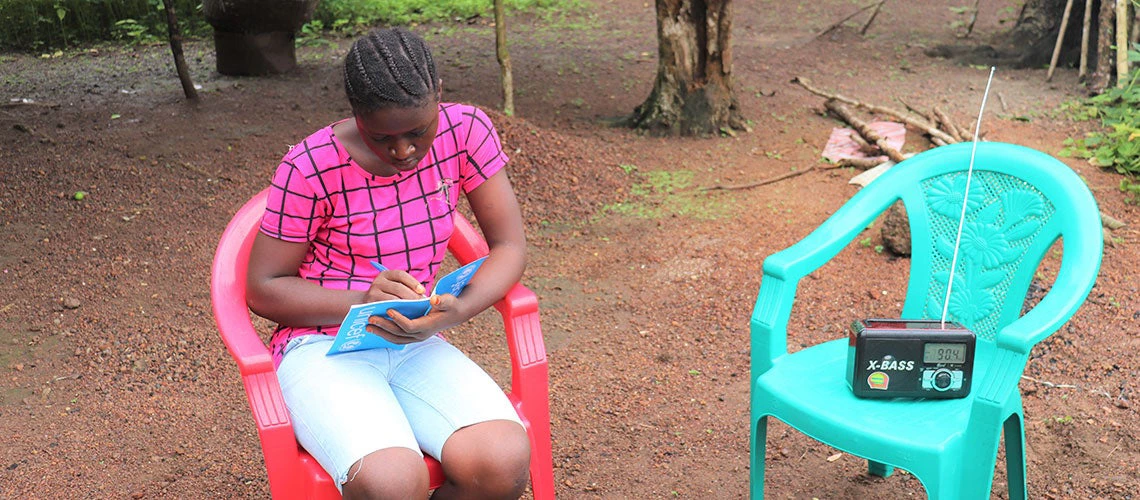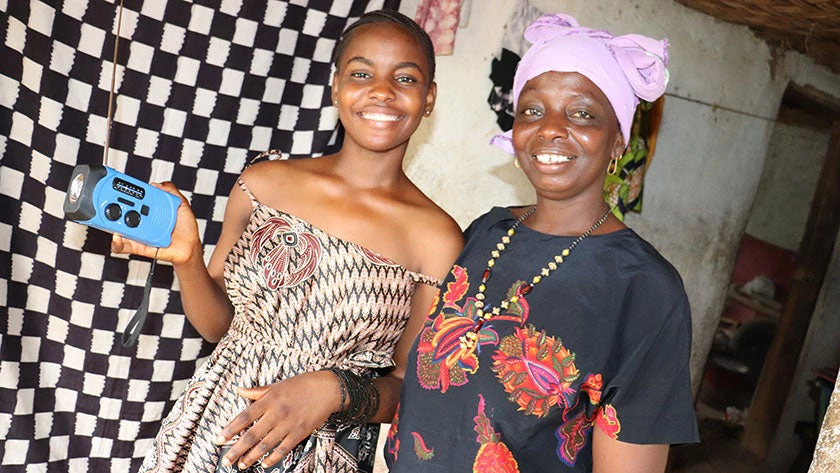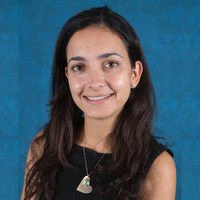 A pupil in Kambia district listening to the Radio Teaching Program. Sierra Leone. © Sierra Leone Ministry of Basic and Senior Secondary Education.
A pupil in Kambia district listening to the Radio Teaching Program. Sierra Leone. © Sierra Leone Ministry of Basic and Senior Secondary Education.
The Ebola crisis
In 2014, the Ebola crisis hit Sierra Leone. A country of only 6.2 million people had more than 14,000 cases and lost close to 4,000 lives to this deadly disease. Ebola caused deep economic and social disruption. Most children were eating less, learning less, and facing increased violence and exploitation. More than twelve thousand children were left orphaned.
The education sector was one of the first in line to be heavily affected by the virus. Schools were closed for eight months and upon reopening, girls ages 12–17 were 16 percentage points less likely to be in school. Child labor by girls increased by 19 percentage points. Teenage pregnancy increased by up to 65% in some communities due to the socioeconomic conditions imposed by the outbreak.
Addressing the challenges of learning loss, out-of-school child vulnerability, and rebuilding the system would prove to be the most pressing issues that the Government of Sierra Leone (GoSL) and its development partners needed to focus on in order to not only protect the education system, but also build sustainable structures to ensure a resilient system ready to face future crises. GoSL and development partners moved quickly with regards to learning loss and system fortification for rebuilding, resulting in strong programs that would buffer Sierra Leone's education system, further preparing it for the COVID-19 Pandemic.
What interventions built this resilience?
Distance learning via the Radio Teaching Program (RTP). Given Sierra Leone’s low access to internet (16%) and television, the government responded through a radio education program which reached over 1 million children. Radio remains the leading media channel in Sierra Leone with 81% of the population having access. The RTP broadcasted lessons five days a week, in 30-minute segments, based on the primary and secondary school curricula in core academic subjects. To increase interactivity, students could call in with questions at the end of the lesson. Despite a lack of signal and of devices posing challenges to its access, the radio program maintained a link to learning during the crisis.
Ensuring students’ safe return and maintaining no new cases. Post-Ebola, the Sierra Leonean government disinfected schools that were used as treatment centers; equipped schools with essential health supplies (thermometers, soap, hand washing stations, chlorine, gloves); trained teachers on disease identification and control, and on psychosocial support; and implemented real-time data collection through school visits (the Situation Room).
Accounting for learning loss to build back stronger. The government then simplified its curricula and implemented two shortened academic years with an accelerated syllabus that focused on core subjects; increased education budgets and announced a National Back to School Campaign which waived tuition fees for two years, and development partners, along with civil society organizations and NGOs, provided books, uniforms, and school supplies to offset education costs borne by families.
Protecting children, especially girls, from the vulnerability that came with being out of school within the context of Sierra Leone’s existing socioeconomic conditions (high sexual and gender-based violence [SGBV] rates and poverty rates), was a difficult challenge to predict. However, the aforementioned programs and the lessons that came with them— coupled the staggering post-school-closure teen-pregnancy rates, were well carried into fortifying the education sector for future crisis.

The Covid-19 Pandemic
Investments made during the Ebola crisis made the Sierra Leonean education system more resilient. When Covid-19 hit, the Ministry of Basic and Senior Secondary Education (MBSSE) could adapt the lessons learned and school safety protocols developed during Ebola to keep children and teachers safe.
Heres how they did
Readily available RTP to expand and build on. Just one week after schools were closed, the Ministry was able to revive the radio teaching program built during the Ebola school closures, as a distance education alternative. The Ministry vastly increased the reach of the radio program, which is transmitted through the MBSSE’s dedicated broadcasting station, by partnering with local radio stations and development partners. Using partnerships, it delivered 25,000 solar- and wind-powered radios to remote communities and vulnerable children, particularly girls, to increase reach. Important efforts have also been made to improve the quality of the radio program: the sessions have been revised and complemented by specialists, and technologies such as a USSD-based mobile dictionary are being launched. Rigorous evaluations analyzing the effectiveness of sending SMS reminders to parents to have their children listen to the radio program, as well as having teachers call children to go over what they learned on the radio are currently being carried out— among other interventions. The Teaching Service Commission also used this technology for teacher training during school closures: teachers were trained through radio lessons which were complemented with printed materials.
Importantly, the Ministry plans to continue broadcasting the radio teaching program now that schools have reopened, giving children the chance to learn both at schools and at home and making the system even more resilient. Moreover, they are using geospatial analysis to strategically place transmitters and ensure that all territories will be covered with broadcast from government or community radios.
Readily available Situation Room. Data collection at the school level, which started with the Situation Room during Ebola, became an angular stone to the country’s decision-making process during the COVID-19 school closures. In fact, the government now carries out a digital Annual School Census which captures accurate data on all preschools, primary, junior and senior secondary schools using tablets. The Census includes data on enrollment; student repetition and transfers; number of children with special needs; availability of basic inputs (e.g. number of children without seating space; number of textbooks by subject); student and teacher absenteeism; teacher’s gender, experience and qualifications; infrastructure (including access to electricity, water, sanitation, and hygiene [WASH], pictures of the infrastructure and GPS coordinates) among other variables.
Preventing pandemic-induced teen-pregnancy rates. This time around, the Ministry also created a strong communication campaign with gender-specific messages and launched it during school closures. Additionally, the Government launched a pilot One Stop Centres program to ensure confidentiality, psychosocial counselling, free medical treatment, legal support and access to other referral pathways in a fight against school-related gender-based violence.
Rebuilding from resilience to efficiency. Now that schools have reopened, teachers are also receiving training on accelerated learning pedagogies. In the long term, the Ministry plans to connect all schools to the internet and distribute one tablet per school to improve management capacity and to enhance continuous professional development of teachers and principals.
Conclusion and future outlook
The World Bank, as well as other development partners, have been supporting the Government’s efforts for continuous and better learning under both the Ebola and COVID-19 crises. We have also learned, along with the country, how to traverse crisis in order to increase the resilience, equity and personalization of education systems.
RELATED
- PROJECT: Sierra Leone Free Education Project
- Results Story - Protecting Children from Learning Loss: Sierra Leone’s Experience with Distance Learning and Keeping All Students Safe
- BLOG: Sierra Leone took Major First Step Towards Keeping Girls in School and Inclusive Education
- BLOG: Digital School Census in 10 Weeks? How it was done in Sierra Leone
- Podcast on Leveraging Educational Radio for Continued Teaching and Learning during COVID-19: A Conversation with the Sierra Leone Teaching Service Commission



Join the Conversation